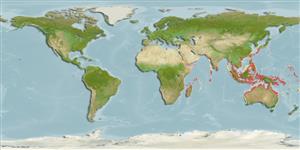>
Eupercaria/misc (Various families in series Eupercaria) >
Gerreidae (Mojarras)
Etymology: Gerres: Latin, gerres = a kind of anchovies; cited by Plinius.
More on author: Cuvier.
Environment: milieu / climate zone / Tiefenbereich / distribution range
Ökologie
seewasser; brackwasser demersal; amphidrom (Ref. 51243). Tropical
Indo-West Pacific: India and Sri Lanka to southeast Asia and the South China Sea. Reported in Iran (86648).
Size / Gewicht / Alter
Geschlechtsreife: Lm ? range ? - ? cm
Max length : 15.0 cm TL Männchen/unbestimmt; (Ref. 3409); common length : 10.0 cm TL Männchen/unbestimmt; (Ref. 3409)
Rückenflossenstacheln (insgesamt) : 9; Rückenflossenweichstrahlen (insgesamt) : 10; Afterflossenstacheln: 3; Afterflossenweichstrahlen: 7. Scales between 5th dorsal fin spine base and lateral line 2.5-3 (usually 2.5). Second anal fin spine more robust than 3rd. Premaxillary groove without scales. Posterior margin of maxilla beyond a vertical through anterior margin of inner dermal eye opening. Diffused dark saddle patches along the back of live specimens 4 or 5: 1st saddle on nape; 2nd under second to 6th or 7th dorsal fin spine; 3rd beneath anterior soft part of dorsal fin; 4th beneath posterior soft part of dorsal fin; 5th on 1/3 upper caudal peduncle (or extending onto upper caudal peduncle or absent). Dorsal fin faint yellowish, with a dark patch on tip of spinous portion above a line running from middle of second dorsal spine to tip of 6th dorsal spine (rarely broader or otherwise indistinct with growth). Caudal fin pale yellow (often with a dusky trailing edge). Anal fin with anterior half yellow or dull orange, posterior whitish hyaline (Rarely dusky). Pectoral fins yellowish color, grading to hyaline at the tip. Pelvic fins yellow or dull orange (hyaline in Thai and Indonesian specimens). Supraneural bones 3.
Body shape (shape guide): short and / or deep; Cross section: compressed.
Lives in tidal areas of estuaries and very shallow coastal waters. Feeds on small animals living on mud-sand bottoms. Marketed fresh (Ref. 3409).
Life cycle and mating behavior
Geschlechtsreife | Fortpflanzung | Ablaichen | Eier | Fecundity | Larven
Iwatsuki, Y., S. Kimura and T. Yoshino, 2001. Gerres limbatus Cuvier and G. lucidus Cuvier from the Indo-Malay Archipelagos, the latter corresponding to young of the former (Perciformes: Gerreidae). Ichthyol. Res. 48(3):307-314. (Ref. 41524)
IUCN Rote Liste Status (Ref. 130435: Version 2025-1)
Bedrohung für Menschen
Harmless
Nutzung durch Menschen
Fischereien: kommerziell
Tools
Zusatzinformationen
Download XML
Internet Quellen
Estimates based on models
Preferred temperature (Ref.
123201): 24.8 - 29.3, mean 28.5 °C (based on 2621 cells).
Phylogenetic diversity index (Ref.
82804): PD
50 = 0.5000 [Uniqueness, from 0.5 = low to 2.0 = high].
Bayesian length-weight: a=0.01445 (0.00833 - 0.02507), b=3.05 (2.90 - 3.20), in cm total length, based on LWR estimates for this species & Genus-body shape (Ref.
93245).
Trophic level (Ref.
69278): 3.5 ±0.37 se; based on food items.
Widerstandsfähigkeit (Ref.
120179): hoch, Verdopplung der Population dauert weniger als 15 Monate. (Preliminary K or Fecundity.).
Fishing Vulnerability (Ref.
59153): Low vulnerability (10 of 100).
🛈
